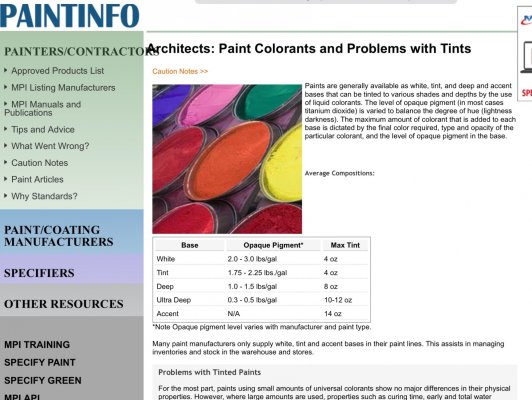Midpack, I realize that you are just relaying the paragraph of info below, so I'll try not to shoot the messenger

.....From someone involved in the retail side of paint for a decade:
You're reading waaaaayyy too much into this!
* Tint-bases (tb) have varying fill-levels ON PURPOSE.
* Whiter/Lighter colors go into a "fuller" tint-base (often @ 124-128 oz. fill).
* This allows 2 oz. of colorant to be added...and leaves 2 oz. worth of "shaking/over-tinting" wiggle-room.
* You could view 132 oz. as a TOTALLY full gallon, but mixing would be very difficult!
* For medium colors, there's usually a couple medium-fill bases.
* The darkest colors go into the least full base, often @ a labeled 114-116 oz's!!
* This leaves room for a LOT more colorant for the real dark colors.
This explanation has two problems.
As I said up top, I don't think anyone is dropping 12 Oz. (1 1/2 cups!) of tint into a ~gallon of paint. I have never seen it. That is an incredible amount of tint. At that rate, store personnel would be changing out the tint canisters at a very fast rate... like might as well back up a tint-tanker to the back door

The second problem is simple volumetrics. Someone says there are 114 - 116 Oz. because dark colors can take so much tint to be added(!) to make... and yet the smaller amount of bases are coming now in shorter cans, that cannot take a gallon, because they are so small... hmmm, maybe those short squat cans are like Dr. Who's Tardus, bigger on the inside than the outside! I don't buy it.
I took a look around my place today to see what I have laying around, I measured can height versus marked volume. Some volumes I had multiple cans of. This is what I found:
128 Oz. 7 3/4" tall
126 Oz. 7 3/4" tall
124 Oz. 7 3/4" tall (one of these was a dark interior color)
122 Oz. none found
120 Oz. 7 3/4" tall (this one oddly enough was a light exterior color)
Since all of the above are in true one gallon cans, they might have come up close to a gallon when tint was added. But I really doubt the 120 Oz. can needed 8 Oz. of tint (1 cup!), and for a pretty light color!
But NONE of these that I have are in squat cans like I saw Wednesday. A squat can that is well under a gallon in volume will by definition not have room for a gallon. So if someone is telling me that a squat 114 Oz. can, with tint added, approaches a gallon (almost 2 cups more!), then they must be putting the tint into a Zip-Loc bag for the customer to take home and mix up themselves in some bigger container. Or they have invented a new scaled-down liquid measure... the Short Gallon, made of Short Ounces, Short Cups, etc. etc.
There is a paint guy I know I can trust, but I don't see him very often, and he is usually loaded with customers when I do, not a good time to talk about this topic with him. Sometime, when the opportunity presents itself, I'll quiz him on it.
Somewhat separately... every week I get a Lowe's sales ad in the mail. I noticed now that they never say "Gallon". The only reference to volume is in the text, where it says 114 or 116 Fl. Oz. The word "Gallon", the standard measure of paint, has disappeared.



